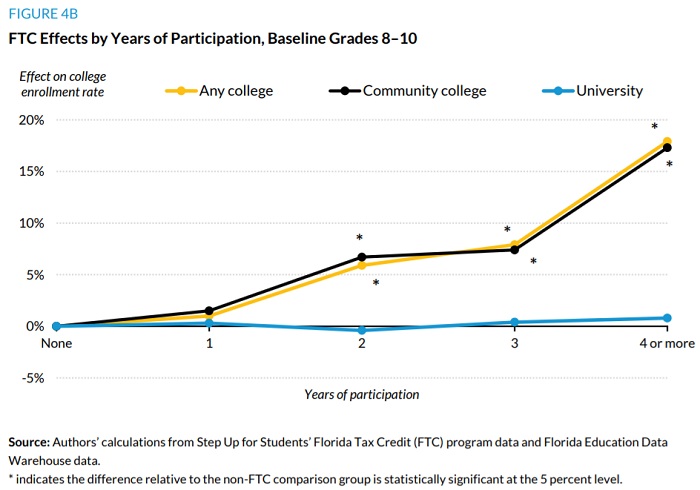Media

Education Choice Boosts Higher Ed Enrollment
Recent studies on voucher programs in Milwaukee, Washington, DC, and Florida once again demonstrate education choice benefits families and taxpayers.
Milwaukee
A longitudinal study—which tracks individual students over long periods of time—compares Milwaukee Parental Choice Program (MPCP) students with Milwaukee Public Schools (MPS) students of similar backgrounds. According to the study, MPCP students obtain higher levels of educational attainment in terms of college enrollment rates and college retention rates. The study shows positive effects for student groups in both the younger grades (3rd through 8th) and in high school (9th). In other words, parents need the freedom to exercise education choice throughout their child's education career.
Washington, DC
A study on the effects of Washington DC’s voucher program on college enrollments shows “no significant difference” when comparing DC’s Opportunity Scholarship Program (OSP) recipients with similarly situated students in the public school system. This is discouraging on the surface, but there are other important considerations.
For starters, this is the first experimental study of its kind on a relatively small sample, opening the door for future, more robust studies. The bulk of empirical research shows positive effects for choice programs, so it is important to look at the entire body of research.
Additionally, the study shows the voucher program is cost efficient. The maximum cost of a student voucher is $9,700, contrasted with per pupil spending of $20,000 in DC Public Schools (both figures adjusted for inflation to 2017 dollars). Students in the scholarship program received the same result at less than half the cost.
Florida
The most dramatic results come from an Urban Institute study in Florida, which compared more than 10,000 students who entered the Florida Tax Credit (FTC) program between 2004 and 2010 with similar students who were not in the program. The FTC participants were significantly more likely to enroll in college.
We find that participating in FTC has substantial positive impacts on the likelihood that students enroll in a public college in Florida. Participation in the FTC program increases college enrollment rates by 6 percentage points, or about 15 percent. Almost all of this effect occurs in community colleges (as opposed to four-year universities), which are more financially accessible to the low-income students participating in FTC and are where most Florida students begin their postsecondary education.
We find evidence of larger benefits for students who participate in the program for a greater number of years, with the largest impacts (up to 18 percentage points, a 43 percent increase) for students who spend four or more years as FTC students. This may be because students who benefit the most from the program also remain in the program the longest. Thirty-seven percent of FTC students participate in the program for only one year, and these students do not appear to benefit from the program.
The graph below shows students who spent more years in the program were more likely to enroll in college.

Graphic/Image Source: Urban Institute. Chingos and Kuehn, “The Effects of Statewide Private School Choice on College Enrollment and Graduation: Evidence from the Florida Tax Credit Scholarship Program,” September, 2017 (21).
This is wonderful news for kids in Milwaukee, DC, and Florida, and it shows the importance of offering more education options in Pennsylvania. While vouchers aren’t on the table in Pennsylvania, Education Savings Accounts (ESAs), an expansion of the Educational Improvement Tax Credit (EITC), and an expansion of the Opportunity Scholarship Tax Credit (OSTC) would empower parents to choose the best educational fit for their children.
ESAs are under consideration by the Senate Education Committee in the form of Senate Bill 2, which would allow parents to use a portion of the state's per-pupil state spending to pay for a la carte educational services. For example, a parent might supplement their child’s private education with an online AP calculus course, speech therapy, or music lessons. ESAs would offer Pennsylvania families unprecedented levels of choice and customization based on the specific needs of the child.
Pennsylvania’s students are being left behind. It’s time to expand education choice and give more kids a chance to succeed.